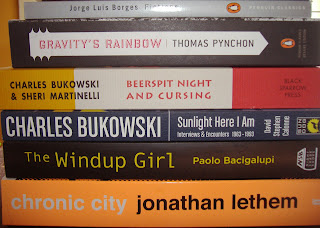This
time last year I began writing book reviews for Excelsior. It started as a way
to develop writing discipline when I made up my mind to start writing
creatively again. I figured that working on book reviews would keep me writing
even when I didn’t feel particularly creative. It has worked wonderfully. My
writing has improved significantly over the last year and I have made a start
on a novel and some short stories.
The
whole process has also made me think about criticism and its worth. After all,
the Internet has helped make everyone a critic now, for better or for worse.
Websites like my own and those linked from my bloglist offer a guide for people
wondering just what book to read next or which book to avoid. For readers there
is also great value in disagreeing with what a critic has to say about a
particular book because it helps to develop their own critical abilities. This
is also one of the best reasons for writing reviews – it makes you a far better
reader and in my case, a far better writer.
Over
the last year I’ve read and reviewed twenty-five books. Some of these I’ve read
for the book club I run at Subiaco Library. Most of these I would never have
read if it wasn’t for the book club. Although this is sometimes a chore I’ve
come to realize over the years that reading books that you wouldn’t normally
consider has great intrinsic value. It exposes you to styles and authors that
wouldn’t normally come your way. There is also great benefit in reading a book
that you don’t particularly enjoy. The critical insight gained can end up being
invaluable. There’s also something to be said for a certain level of discipline
when it comes to reading. Next time you start a book and it doesn’t appeal to
you, keep going because it may just make you a better reader and a better
critic.
Of
the twenty-five books I’ve reviewed over the last year only two gained my
highest rating of sublime.
These were Carson McCullers The Heart is a Lonely Hunter and John Fowles The
Magus.
For these two novels it is excusable to wheel out that dead cliché – “work of
genius.” Both are brilliantly written and both show just how weighty issues can
be approached without resorting to dumbing down or empty cliché. Although the
other books featured over the last year were not in the same league, they are
all worthy in one way or another. The only book I’d advise readers to think
twice about reading is Allan Hollinghurst’s The
Stranger’s Child; although this book gave me valuable insight regarding
just what to avoid in my own writing.
So,
another year of reading and writing awaits. The publishing industry may be
going through great changes
at the moment, but something that I’m sure will never change is the desire to
immerse oneself in a great novel from which so much enjoyment and knowledge can
be gained. Surely there aren’t many better ways to spend your time? After all,
reading and writing helps to both define and to critique humanity, something we
must never lose sight of in this age of endless distractions.


